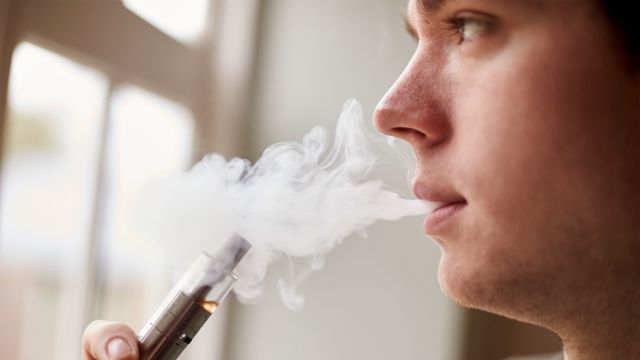Updated on January 10, 2024.
If you’re the parent of a teen—or even a “tween” who’s navigating middle school—you need to know about e-cigarettes. Odds are that your child not only knows about e-cigarettes, but also has access to them and may be tempted to try one, if they haven’t already.
Don’t be fooled. Despite being marketed and advertised as a healthier alternative to smoking, e-cigarettes pose significant health risks, which may be particularly harmful for young people with developing minds and bodies. In the United States, e-cigarette use, or vaping, among kids and teens has increased dramatically over the years.
According to the Centers for Disease Control and Prevention (CDC), e-cigarettes have been the number one tobacco choice for youth in the United States since 2014. In 2022, more than 3 percent of middle school students and more than 14 percent of high school students reported using e-cigarettes in the previous 30 days. That’s a total of 2.55 million students.
To put this into perspective, in 2011, only 1.5 percent of high school students and just 0.6 percent of middle school students reported using e-cigarettes.
The worrisome trend prompted the U.S. Surgeon General to issue an advisory on the e-cigarette epidemic among American youth in December 2018. Yet, despite increasing warnings, some parents still aren’t aware of just how pervasive e-cigarettes have become, while others may assume their child isn’t at risk, says Russell Delaney, MD, a pediatrician affiliated with LewisGale Medical Center in Salem, Virginia.
“Almost every middle schooler and high schooler that I’ve talked to tells me that they know people who are using e-cigarettes, and that they have had an opportunity to use them,” Dr. Delaney says. “Without a doubt there are some parents who are naïve about how prevalent vaping is in the schools and that their children may be doing it.”
Here’s what you need to know about how e-cigarettes work, why they are harmful, and how you would even know if your child is using them.
What is a JUUL anyway?
Brace yourself. According to the CDC, in December 2022 there were more than 269 different e-cigarette brands being sold to consumers in the U.S., up from 184 in January of 2020. You might hear a variety of different terms—like e-cigs, vapes, vape pens, mods, and hookah pens—but they’re all e-cigarettes.
JUUL, a particular brand of e-cigarettes, has emerged as one of the most popular products, along with Vuse, Elf Bar, NJOY, and Breeze Smoke. In 2017 and 2018, when the popularity of e-cigarettes with kids was spiking, JUUL was consumers’ top choice, so the name has become somewhat synonymous with e-cigarettes.
Here’s where things get even more tricky. E-cigarettes come in different shapes and sizes. They may look like regular cigarettes, cigars, or pipes, but some look like pens or USB memory sticks and can even be charged on a laptop.
But, despite their differing appearances, these products all operate in a similar way. Typically, a cartridge or reservoir of e-liquid or “e-juice” is heated by a battery-powered device, allowing users to breathe in the resulting vapor. The most important thing to understand about vaping is that this vapor isn’t harmless.
Vaping isn’t a ‘safe’ alternative
Like regular cigarettes, most e-cigarettes contain nicotine. A JUUL pod has high levels of nicotine—as much as a pack of cigarettes. Nicotine is highly addictive and exposure during childhood or adolescence poses health risks. Teens who use e-cigarettes may be more likely to start smoking in the future, the CDC reports.
But the CDC also notes that two-thirds of all JUUL users ages 15 to 24 don’t realize that JUUL always has nicotine in it. This may be largely because some product labels don’t disclose the fact they contain nicotine, while others are mislabeled as having none.
Nicotine exposure can harm young brains, which continue to develop until about age 25. Nicotine can not only prime the brain for addiction early on, but also lead to mood disorders and problems with learning, impulse control, memory, decision-making, and attention.
The liquid in e-cigarettes often contains other potentially harmful chemicals, such as acrolein, volatile organic compounds, and metals, like nickel and lead, according to the American Lung Association. These chemicals could increase the risk for heart disease, lung damage, cancer, and other serious health issues. E-cigarettes are also commonly used with THC products.
“Kids are viewing [vaping] as a safer option because they've heard that people use e-cigarettes to try and quit smoking,” Delaney says. “What I'm trying to impress on my patients is that e-cigarettes haven’t been around that long. What are we going to know 50 years from now about the people who started vaping and were addicted to nicotine when they were 14, 15, or 16 years old?”
Appealing to kids
In years past, e-cigarette cartridges and pods could legally contain fruit and candy flavors, like strawberry, grape, chocolate—and even “Unicorn Cakes” and “Smurf Sauce”—that appealed to young people. Many of those e-liquids had labels that resemble kid-friendly foods, such as peanut butter and jelly and popular sugary cereals—a marketing tactic that made them appear less dangerous. Not so.
A small but striking study published in June 2019 in the Journal of the American College of Cardiology found that use of flavored e-cigarettes, in particular, damaged endothelial cells (the main type of cells found in the lining of the blood vessels). Scientists suspect that such damage could lead to heart disease.
Health threats like these are why, in 2020, the U.S. Food and Drug Administration (FDA) banned the manufacture, distribution, and sale in the U.S. of all flavored e-cigarette cartridges or pods except tobacco and menthol, the two least popular flavors among kids. They also prohibited any kid-oriented marketing.
While may sound like a positive development, the FDA allowed key exceptions. Flavors were still allowed in disposable e-cigarettes and e-liquid refills for refillable e-cigarettes. The CDC reports that nearly 85 percent of those 2.55 million kids who used e-cigarettes in 2022 used flavored e-cigarettes, with fruit and candy being the most popular flavors.
EVALI
In 2019, health officials began investigating increasing reports of a mysterious vaping-related lung illness across the U.S. People experienced serious symptoms such as coughing, shortness of breath, chest pain, nausea, vomiting, fever, chills, and weight loss, which developed over days or weeks. They called this e-cigarette or vaping product use-associated lung injury, or EVALI.
It turned out that vitamin E acetate, a thickening agent used in many THC-containing e-cigarette products, was one of the problematic chemicals. But since the chemistry of the liquids in e-cigarettes is complex, there may have been other substances that contributed to these illnesses.
Yes, it could be your child
Young people with a strong desire to fit in with peers may be more likely to try vaping, while teens with depression or anxiety may use e-cigarettes as a way to self-medicate, notes Delaney. But he urges all parents to assume their child has access to these products and will have an opportunity to try them, if they haven’t already.
“My real take-home message would be: Don't try to figure out which child is at higher risk, because all children—boys, girls, straight-A students, students who are struggling, students who are known to get in trouble, or students who never get in trouble—are at risk,” Delaney cautions. “Know e-cigarettes are there, know children are seeing other kids use them, and know that they will have an opportunity to try them.”
Taking action now to educate yourself and your child. Empowering kids to make healthy choices, and knowing how to handle tempting situations—before they arise—can help kids avoid e-cigarettes and protect their health.







